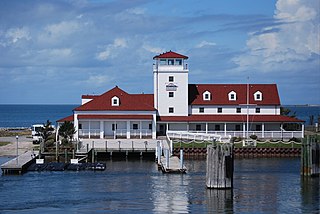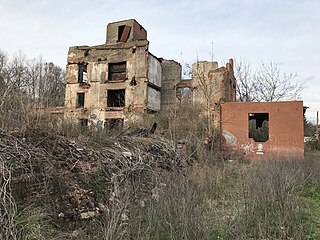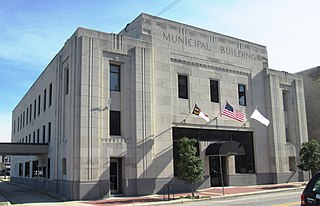Downtown Asheville Historic District is a national historic district located at Asheville, Buncombe County, North Carolina. The district encompasses about 279 contributing buildings and one contributing object in the central business district of Asheville. It includes commercial, institutional, and residential buildings in a variety of popular architectural styles including Colonial Revival, Queen Anne, and Art Deco.

Claremont High School Historic District is a national historic district located at Hickory, Catawba County, North Carolina. The district encompasses 172 contributing buildings and 3 contributing structures in a predominantly residential section of Hickory. Most of the dwellings date from the late 19th through mid-20th century and include notable examples of Queen Anne, Colonial Revival, Tudor Revival, and Bungalow / American Craftsman style architecture. The Claremont High School was completed in 1925, and is a three-story, "H"-shaped, Neoclassical style school. The school was rehabilitated in 1986 as an arts and science center. Other notable buildings include Maple Grove, Shuler-Harper House (1887), Harvey E. McComb House (1889), (former) Corinth Reformed Church Parsonage (1895), Shuford L. Whitener House, Judge W. B. Councill House (1902), George W. Hall House, Carolina Park, Josephine Lyerly House, John L. Riddle House (1918), Marshall R. Wagner House (1938), David M. McComb Jr. House (1939), Arthur H. Burgess House (1940), and R. L. Noblin House (1950).

Trinity Historic District, also called Trinity Park, is a national historic district and residential area located near the East Campus of Duke University in Durham, North Carolina. The district encompasses 751 contributing buildings in a predominantly residential section of Durham. They were built between the 1890s and 1960 and include notable examples of Queen Anne and Bungalow / American Craftsman style architecture. Located in the district are the separately listed "Faculty Row" cottage: the Bassett House, Cranford-Wannamaker House, Crowell House, and Pegram House. Other notable buildings include the George W. Watts School (1917), Julian S. Carr Junior High School (1922), Durham High School (1923), Durham Alliance Church (1927), Trinity Presbyterian Church (1925), Great A & P Tea Company (1927-1929), Grace Lutheran Church, and the former Greek Orthodox Community Church.

Rocky Mount Central City Historic District is a national historic district located at Rocky Mount, Edgecombe County and Nash County, North Carolina. The district encompasses 166 contributing buildings in central Rocky Mount. It includes a variety of industrial, commercial, residential, and institutional buildings dating from the late-19th through mid-20th centuries. Notable buildings include the Firestation No. 2 (1924), Union Bus Station (1951), the Railway Express Agency Building, Memorial Hospital (1937), Church of the Good Shepherd (1877), Atlantic Coastline Railroad Station (1903-1916), Imperial Tobacco Company Processing Plant (1903-1923), S. H. Kress and Company, Belk-Tyler, Grand Theater, Manhattan Theater, Holy Hope Episcopal Church (1910s), and Summerlin House (1895).

Oxford Historic District is a national historic district located at Oxford, Granville County, North Carolina. The district encompasses 201 contributing buildings, 1 contributing site, and 2 contributing objects in the central business district and surrounding residential sections of Oxford. It includes buildings dating from the early-19th century through the 1930s and notable examples of Greek Revival and Late Victorian style architecture. Located in the district is the separately listed Granville County Courthouse (1838-1840). Other notable buildings include the Bryant-Kingsbury House, Taylor-McClanahan-Smith House (1820s), former Granville County Jail, Oxford Women's Club, Titus Grandy House (1850s), Oxford Presbyterian Church, St. John's College, Lyon-Winston Building (1911), Herndon Block Number 2, Hunt Building, L. H. Currin-American Tobacco Company (1860s), and St. Stephens Episcopal Church (1902).

Ocracoke Historic District is a national historic district located at Ocracoke, Hyde County, North Carolina. The district encompasses 228 contributing buildings, 15 contributing sites, and 4 contributing structures on Ocracoke Island in Ocracoke village. The district includes notable examples of Late Victorian, Shingle Style, Bungalow / American Craftsman, and Coastal Cottage style architecture dating from about 1823 to 1959. A number of the houses were constructed from salvaged ship timbers. Located in the district is the Ocracoke Light Station. Other notable contributing resources include the Simon and Louisa Howard House, the Kugler Cottage, Tolson-Rondthaler House, Simon and Sarah Garrish House (1888), Spencer Bungalow (1937), Benjamin Fulcher House, William Charles Thomas House (1899), Styron Store (1920s), Willis Store and Fish House, Coast Guard Station and British Cemetery, the United Methodist Church, Assembly of God Church, the Island Inn (1901), and Berkley Manor and Berkley Castle.
Downtown Selma Historic District is a national historic district located at Selma, Johnston County, North Carolina. It encompasses 59 contributing buildings and 1 contributing structure in the central business district of Selma. It includes notable examples of Classical Revival, Colonial Revival, Art Moderne, Art Deco, and Gothic Revival style architecture and buildings dating from about 1875 to 1960. Notable buildings include the Bank of Selma/American Telephone and Telegraph Exchange Building, Economy Furniture, John A. Mitchener Building (1925), The Rudy Theater, The Hardware Store, Bank of Selma, Selma Baptist Church, and Selma Manufacturing Company/Selma Furniture Store and Opera House (1902).

Jackson Historic District is a national historic district located at Jackson, Northampton County, North Carolina. The district encompasses 168 contributing buildings, 2 contributing sites, 1 contributing structure, and 2 contributing objects in the central business district and surrounding residential sections of Jackson. The district developed between about 1825 and 1953 and includes notable examples of Federal and Greek Revival style architecture. Located in the district are the separately listed Amis-Bragg House, Church of the Saviour and Cemetery, and Northampton County Courthouse Square. Other notable contributing resources include Lewis Drug Store (1930), Kennedy's Five Cents to Five Dollars Store, Bank of Northampton (1928), Bowers Hardware Store, Atlas Oil Company Building, Farmer's Cotton Gin Complex, Faison House, Saint Catherine's Hall (1848), Judge Robert Peebles House (1890s), Selden-Boone House, Jackson Baptist Church (1881), and Jackson United Methodist Church (1937).

Elizabeth City Historic District is a national historic district located at Elizabeth City, Pasquotank County, North Carolina. The district encompasses 592 contributing buildings, 1 contributing site, 1 contributing structure, and 1 contributing object in the central business district and surrounds residential sections of Elizabeth City. The district developed after 1789, and includes representative examples of Greek Revival, Federal, and Late Victorian style architecture. Notable contributing buildings include the Grice-Fearing House (1789-1808), Shirley Armstrong House, Goodman-Matthews-Pool House, Dr. William Martin House, Pool-Kennedy-Lumsden House, Charles-Hussey House, Richardson-Pool House, North Carolina Building (1859), Cobb Building, the former First Methodist Church, Christ Episcopal Church (1857), J. W. Dent House, Dr. Butt's Drug Store, the McMullen Building, the Lowrey Building, former Citizens Bank, Robinson Building (1903), Kramer Building (1909), Selig Building (1925), the Virginia Dare Hotel and Arcade (1927), First Baptist Church (1889), United States Post Office and Courthouse, and Pasquotank County Courthouse (1882).

Hertford Historic District is a national historic district located at Hertford, Perquimans County, North Carolina. The district encompasses 219 contributing buildings, 2 contributing sites, 1 contributing structure, and 1 contributing object in the central business district and surrounding residential sections of Hertford. The district developed between about 1759 and 1948, and includes notable examples of Federal, Greek Revival, and Gothic Revival style architecture. Located in the district are the separately listed Perquimans County Courthouse and Church of the Holy Trinity. Other notable buildings include the Creecy-Skinner-Whedbee House, Edward Wood House, Matthews-Jacocks House, Temperance Hall (1851), Matthew H. White House, Dr. Thomas S. McMullan House (1905), Thomas Nixon House, William M. Divers House (1924), W.R. Shannonhouse Building (1895), Darden Department Store, Farmers National Bank of Hertford (1916), State Theatre (1937), Old Hertford Post Office (1915), Hertford Baptist Church (1854), and Hertford United Methodist Church (1901).

Franklinville Historic District is a national historic district located at Franklinville, Randolph County, North Carolina. The district encompasses 137 contributing buildings, 1 contributing site, and 5 contributing structures in the central business district and surrounding residential sections of Franklinville. It includes buildings built between about 1819 and the late 1920s and notable examples of Victorian and Greek Revival architecture. Notable buildings include the Franklinville Manufacturing Company complex, Johnson-Julian House, Horney-Curtis-Buie House, a group of antebellum mill houses, Madison Brower House, Hanks Lodge (1850), Frazier-Fentress House, Franklinville Methodist Church (1912-1913), Grove Hotel (1915-1919), and Franklinville Store Company (1920).

Clinton Commercial Historic District is a national historic district located at Clinton, Sampson County, North Carolina. The district encompasses 67 contributing buildings and 4 contributing objects in the central business district of Clinton. It developed between about 1902 and 1951, and includes notable examples of Colonial Revival, Tudor Revival, and Classical Revival architecture. Located in the district are the separately listed Bethune-Powell Buildings, Clinton Depot, and Johnson Building. Other notable buildings include the Sampson County Courthouse, Bank of Sampson (1902), Henry Vann Building (1924), William's Building, DuBose Building (1938), and U. S. Post Office (1936) designed by the Office of the Supervising Architect under Louis A. Simon.
West Main–North Chesnutt Streets Historic District is a national historic district located at Clinton, Sampson County, North Carolina. The district encompasses 44 contributing buildings in a predominantly residential section of Clinton. It developed between about 1830 to the early 1930s, and includes notable examples of Greek Revival, Colonial Revival, and Gothic Revival architecture. Notable buildings include the Richard Clinton Holmes House, Amma. F. Johnson House (1868), Dr. William G. Micks House (1851), William Hubbard House, R. H. Hubbard, Sr. House, St. Paul's Episcopal Church (1902), L. C. Graves Presbyterian Church (1908), C. B. Barrus House (1923), the Hathcock-Hobbs House, the Gabe Barbrey House (1932), and the F. L. Turlington House (1937).

Downtown Elkin Historic District is a national historic district located at Elkin, Surry County, North Carolina. The district encompasses 51 contributing buildings and 2 contributing structures in the central business district of Elkin. They were primarily built between about 1890 and 1950 and include notable examples of Early Commercial and Bungalow / American Craftsman architecture. Notable buildings and structures include the Gwyn-Foard House, Hugh G. Chatham Bridge (1931), Liberty Tobacco Warehouse, Harris Building (1902), U.S. Post Office (1937) designed by the Office of the Supervising Architect under Louis A. Simon, former Elkin Town Hall (1938–1939) built by the Works Progress Administration, Dobbin's Store, and the Riverside Hotel (1915–1925).

Gwyn Avenue–Bridge Street Historic District is a national historic district located at Elkin, Surry County, North Carolina. The district encompasses 124 contributing buildings and 1 contributing site in a predominantly residential section of Elkin. They were primarily built between about 1891 and 1955 and include notable examples of Queen Anne, Colonial Revival, and Bungalow / American Craftsman architecture. Notable buildings include the Elkin Presbyterian Church, First Baptist Church, Alexander Martin Smith House (1893–1897) designed by George Franklin Barber, the Gwyn-Chatham-Gwyn House, Richard Gwyn Smith House, and Mason Lillard House.

Mount Airy Historic District is a national historic district located at Mount Airy, Surry County, North Carolina. The district encompasses 187 contributing buildings in the central business district and surrounding industrial and residential sections of Mount Airy. They were primarily built between about 1880 and 1930 and include notable examples of Late Victorian and Bungalow / American Craftsman architecture. Located in the district are the separately listed W. F. Carter House and Trinity Episcopal Church. Other notable buildings include the Abram Haywood Merritt House (1902), William A. Estes House, Thomas Fawcett House, J. D. Sargent House (1919), Campbell A. Baird House (1913), T. Benton Ashby House, First Baptist Church (1906-1912), Mount Airy Friends (1904), Presbyterian Church (1907-1914), Merritt Building, Banner Building (1906), Prather Block, Midkiff Hardware Store, Welch Block, West Drug Store, Belk's Building, (former) Workman's Federal Savings and Loan, (former) First National Bank (1893), Bank of Mount Airy (1923), U.S. Post Office (1932-1933), and the Sparger Brothers Tobacco Factory.
Downtown Garner Historic District, also known as Garner's Station, is a national historic district located at Garner, Wake County, North Carolina. The district encompasses 62 contributing buildings and 1 contributing site in the central business district and surrounding residential sections of Garner. The district developed between about 1883 and 1940 and includes notable examples of Queen Anne, Classical Revival, and Bungalow / American Craftsman style architecture. Notable buildings include the Garner Depot, (former) Garner High School (1923), Hayes Chapel Christian Church, H. D. Rand Store, Bank of Garner Building, Section Foreman's Bouse, Joe Broughton Bouse, J. J. Bagwell House, W. L. Brooks House, and D. B. Buffaloe House (1923).

Plymouth Historic District is a national historic district located in Plymouth, Washington County, North Carolina. The district encompasses 258 contributing buildings, 5 contributing sites, and 1 contributing structure in the central business district and surrounding residential sections of Plymouth. It was largely developed between about 1880 and 1930 and includes notable examples of Colonial Revival, Bungalow / American Craftsman and Late Victorian style architecture. Located in the district are the separately listed Latham House, Perry-Spruill House, and Washington County Courthouse. Other notable buildings include the Hornthal-Owens Building, Blount Building, Atlantic Coast Line Railroad Station (1923), Davenport-Davis House, Robert Ward Johnston House (1924), Latham-Brinkley House (1883), Plymouth United Methodist Church and Cemetery, Grace Episcopal Church and Cemetery designed by Richard Upjohn, New Chapel Baptist Church (1924), Agricultural Building (1936-1937) constructed through the Works Progress Administration, Plvmouth Railroad Station (1927), Brinkley Commercial Block (1926), and Clark-Chesson House.
Mount Olive Historic District is a national historic district located at Mount Olive, Wayne County, North Carolina. The district encompasses 465 contributing buildings, 2 contributing structures, and 1 contributing object in the central business district and surrounding residential sections of Mount Olive. It developed between about 1838 and 1949, and includes notable examples of Italianate and Queen Anne style architecture. Located in the district are the separately listed former United States Post Office, Mount Olive High School (Former), Southerland-Burnette House, and Perry-Cherry House. Other notable contributing buildings are the Elms, Mount Olive Presbyterian Church (1916), Carver High School (1941), Wooten & Brothers Building, DeBrutz English House, Center Theatre (1947), Mount Olive Manufacturing Company (1914), Farrior-Wooten House, Mount Olive First United Methodist Church (1911-1913), Mt. Olive Pickle Co. Office (1920), Mount Olive Passenger Depot, and Ebenezer Apostolic Holiness Church (1850).

The Wilson Central Business–Tobacco Warehouse District is a national historic district located at Wilson, Wilson County, North Carolina. It encompasses 152 contributing buildings, 20 contributing sites, and 2 contributing structures in the central business district of Wilson. The district includes notable examples of Late Victorian and Art Deco style architecture. Located in the district are the separately listed Branch Banking Building, Cherry Hotel, and Wilson County Courthouse. Other notable buildings include the Woodard-Watson Warehouse, Planter's Warehouse, Passenger Station and Freight Depot (1924), Jackson Chapel First Baptist Church (1913), St. John's African Methodist Episcopal Church (1915), Imperial Tobacco Company, Winstead-Hardy Building, Rountree Building (1870s), Planter's Bank Building (1920), United States Post Office and Courthouse (1927), Charles L. Coon High School (1922), First National Bank of Wilson Building (1927), Wilson Theatre (1922), Odd Fellows Lodge (1896), and the Works Projects Administration financed Wilson Municipal Building (1938).



















